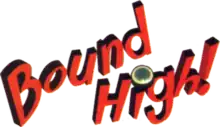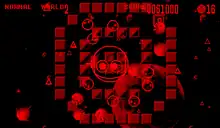| Bound High! | |
|---|---|
 Preliminary logo | |
| Developer(s) | Japan System Supply |
| Publisher(s) | Nintendo |
| Designer(s) | Hideyuki Nakanishi |
| Composer(s) | Takaaki Oka |
| Platform(s) | Virtual Boy |
| Release | Unreleased |
| Genre(s) | Action, puzzle |
| Mode(s) | Single-player |
Bound High![lower-alpha 1] is an unreleased action-puzzle video game that was in development by Japan System Supply and planned to be published by Nintendo on a scheduled 1996 release date exclusively for the Virtual Boy. In the game, players take control of a transforming robot named Chalvo through a series of levels riddled with hazardous obstacles to avoid across multiple worlds, while destroying or knocking out alien invaders off the area. The project was first conceptualized by designer and programmer Hideyuki Nakanishi, who wrote the idea on paper and placed it within a wall inside the offices of Japan System Supply, with his manager eventually greenlighting its development after seeing it.
Although showcased at various trading shows and completed for release, Bound High! was ultimately shelved due to the failure of the Virtual Boy itself. After its cancellation, a follow-up on the Game Boy titled Chalvo 55 was released in 1997. Despite its cancellation, a ROM image of the complete game was leaked online in 2010 by the hobbyist community at Planet Virtual Boy, allowing for it to be played.
Gameplay

Bound High! is a top-down action-puzzle game where players take control of Chalvo, a robot who transforms itself into a bouncing ball. The game's objective is to destroy or knock out enemies from the playfield and figuring out the best way to dispatch them while avoiding hazardous obstacles. Falling out of the playfield results in a lost life and all the previously defeated enemies are respawned. If all lives are lost, the game is over.[1]
Bound High! has four game modes to choose from, each one having their own ruleset and main objectives: Adventure of Chalvo, Score Attack!!, Random Game and Pocket and Cushion. Adventure of Chalvo features multiple sets of levels, with a story centered around Chalvo defending Earth from aliens. Power-ups are also available which help players defeat enemies more efficiently. Upon completing four stages, a fifth stage must be played where players join + and - orbs together to gain points. On every 10th level, a boss must be fought. Score Attack!! is a score-based mode where players attempt to defeat all enemies in a stage in the most efficient manner. Random Game is a skirmish mode where players are placed in procedurally-generated stages. Pocket and Cushion tasks players with getting balls into a hole in the fastest time possible to achieve a high score.[1]
History

Bound High! was conceived by Chameleon Twist creator Hideyuki Nakanishi at Japan System Supply, who worked as one of the designers and programmers on the project as an undergraduate student.[2][3] Nakanishi had looked at game plans on the desk of the company's president and found them uninteresting. This led to Nakanishi creating a summary for Bound High! and leaving it on the wall for the president to find. This led to the project being greenlit. One of Nakanishi's co-workers handled the sound programming along with composer Takaaki Oka, while Nakanishi handled everything else. More members eventually joined the development process.[2]
Bound High! was first showcased to the video game press and attendees of Shoshinkai 1995,[2][4][5][6] and later had its rights purchased by Nintendo, which originally slated it for a February 23, 1996 release.[7][8][9][10] It was later showcased at E3 1996 and was set to be one of the first games for the relaunch of the Virtual Boy along with Intelligent Systems' Dragon Hopper.[11][12][13][14][15] It was slated for a August 26, 1996 launch in both United States and Japan;[1][16][17][18][19] however it was never released due to Nintendo discontinuing the Virtual Boy for being a commercial failure.[20][21][22][23]
On May 3, 2010, a complete ROM image compiled from the source code of Bound High! that was acquired by hobbyist community Planet Virtual Boy was leaked online.[24][25] A limited number of reproduction copies were created and released, complete with packaging mimicking officially licensed Virtual Boy releases.[24]
Reception and legacy
Prior to the discontinuation of the Virtual Boy that led to Bound High! being cancelled, former Nintendo president Hiroshi Yamauchi called the game as "the most promising title" during his keynote speech at Shoshinkai 1995.[2][6] In a preview, Nintendo Power referred to its design as "fiendish." They later praised it, noting that it had the potential to be one of the best Virtual Boy releases.[26][27] 1UP.com's Todd Ciolek regarded it as a notable cancelled game, praising its use of the Virtual Boy's visual design.[28][29] Retronauts writer Jeremy Parish speculated that the release of Star Fox 2 on the SNES Classic could lead to Bound High! seeing a proper release as well.[30]
After the release of Bound High! on Virtual Boy was cancelled, Japan System Supply took most of the ideas and the soundtrack when developing a follow-up on the Game Boy titled Chalvo 55 that was released in February 1997.[31] Hideyuki Nakanishi was not involved during its development due to lack of interest.[2]
Notes
References
- 1 2 3 "The Second Coming". Total!. No. 56. Future plc. August 1996. p. 9. Archived from the original on July 13, 2017. Retrieved January 17, 2019.
- 1 2 3 4 5 Radke, Christian (October 2003). "Interviews - Hideyuki Nakanishi". Planet Virtual Boy. Archived from the original on June 12, 2018. Retrieved January 31, 2019.
- ↑ Nakanishi, Hideyuki. "Hideyuki Nakanishi's game designs". Symbiotic Media Group. Archived from the original on February 18, 2019. Retrieved February 1, 2019.
- ↑ "BOUND HIGH! - VB". Famitsu (in Japanese). No. 363. ASCII. December 1, 1995. p. 110. Archived from the original on June 11, 2015. Retrieved January 17, 2019.
- ↑ "Virtual Boy Life - Bound High". The Super Famicom (in Japanese). Vol. 6, no. 23. SoftBank Creative. December 22, 1995. p. 56.
- 1 2 "バーチャルボーイ ゲームフラッシュ - 新作VBゲーム情報発信基地". Dengeki Super Famicom (in Japanese). Vol. 4, no. 1. MediaWorks. January 5–19, 1996. p. 46. Archived from the original on 2019-05-30. Retrieved 2019-09-27.
- ↑ "Out of the Shadows - Nintendo 64 Debuts In Japan - Best of the Rest". Nintendo Power. No. 80. Nintendo of America. January 1996. p. 33. Archived from the original on April 1, 2016. Retrieved January 17, 2019.
- ↑ "Special Messe - Shoshinkai Messe Nachlese". Mega Fun (in German). No. 41. CT Computec Verlag GmbH & Co. KG. February 1996. pp. 94–95. Archived from the original on January 31, 2019. Retrieved January 17, 2019.
- ↑ "Pak Watch - Bound High". Nintendo Power. No. 81. Nintendo of America. February 1996. p. 99. Archived from the original on March 4, 2012. Retrieved January 17, 2019.
- ↑ "Aktuelles - Mario & Wario Im Rotlich-Sektor - Virtual Bros". MAN!AC (in German). No. 29. Future-Verlag. March 1996. pp. 14–15. Archived from the original on January 31, 2019. Retrieved January 27, 2019.
- ↑ "In The Red - Red or Dead - Virtually Here". Total!. No. 53. Future plc. May 1996. p. 38. Archived from the original on July 13, 2017. Retrieved January 17, 2019.
- ↑ "E3 Expo Los Angeles - 1996 Software Lineup". GameFan. Vol. 4, no. 7. Shinno Media. July 1996. p. 32.
- ↑ "Electronic Entertainment Expo E3 - 16-bit Das Finale". MAN!AC (in German). No. 33. Future-Verlag. July 1996. p. 24. Archived from the original on January 31, 2019. Retrieved January 17, 2019.
- ↑ "Messe - E3 Expo Los Angeles '96 - L.A. Messe". Video Games (in German). No. 56. Future-Verlag. July 1996. p. 20. Archived from the original on January 31, 2019. Retrieved January 17, 2019.
- ↑ "Reporte Especial: Expo E3 Los Angeles '96 - Bound High". Club Nintendo (in Spanish). No. 56. Editorial Televisa. 1996. pp. 43–44.
- ↑ "Super Express - Virtual Boy Games Explosion!". Super Play. No. 46. Future Publishing. August 1996. p. 10.
- ↑ "E3 - Only The Beginning: Virtual Boy". Nintendo Power. No. 86. Nintendo of America. July 1996. p. 18. Archived from the original on 2019-05-30. Retrieved 2019-09-09.
- ↑ Eggebrecht, Julian (October 1996). "Reportage - Virtual Boy - Die rot-schwarze 3D-Revolution?". Total! (in German). No. 41. X-Plain-Verlag. pp. 58–61. Archived from the original on July 13, 2017. Retrieved January 17, 2019.
- ↑ "Este Mes En El Barrio...". Club Nintendo (in Spanish). No. 57. Editorial Televisa. 1996. p. 61.
- ↑ "Informacion Virtual - Bound High!". Club Nintendo (in Spanish). No. 59. Editorial Televisa. 1996. p. 21. Archived from the original on September 27, 2017. Retrieved January 17, 2019.
- ↑ "ProNews: Nintendo Kills the Virtual Boy". GamePro. No. 101. IDG. February 1997. p. 27. Archived from the original on July 7, 2018. Retrieved September 7, 2019.
- ↑ Moore, Jason (2004). "The Lost Big Brother: Virtual Boy". Retrogames. No. 22. Archived from the original on 2019-05-30. Retrieved 2019-09-09.
- ↑ "Bound High". Entertainment Software Rating Board. Entertainment Software Association. 2019. Archived from the original on 2019-09-28. Retrieved 2019-09-28.
- 1 2 Kohler, Chris (December 12, 2012). "When Games get Canceled, These Guys Bring them Back to Life". Wired. Archived from the original on December 22, 2016. Retrieved January 31, 2019.
- ↑ Gasking, Frank (August 2020). Nineteen Ninetieth-Nineteen Ninety Nine: Bound High!. Bitmap Books. pp. 386–387.
{{cite book}}:|work=ignored (help) - ↑ "Pak Watch - Bound High". Nintendo Power. No. 83. Nintendo of America. April 1996. p. 101. Archived from the original on June 11, 2015. Retrieved January 17, 2019.
- ↑ M., Andy (October 2005). "Collecting - Virtual Boy's Unsung Hero". Nintendo Power. No. 196. Nintendo of America. p. 105. Archived from the original on June 11, 2015. Retrieved January 27, 2019.
- ↑ Ciolek, Todd (August 6, 2012). "Creative, Compelling, and Canceled: Lost Games that Could Have Shaken the System". 1UP.com. Archived from the original on April 16, 2015. Retrieved January 31, 2019.
- ↑ Ciolek, Todd (October 15, 2012). "Among the Missing: Notable Games Lost to Time". 1UP.com. Archived from the original on October 26, 2015. Retrieved January 31, 2019.
- ↑ Parish, Jeremy (June 27, 2017). "What does Star Fox 2's resurrection mean for other lost games?". Retronauts. USgamer. Archived from the original on 2019-06-07. Retrieved 2019-06-09.
- ↑ "Reporte Shoshinkai Show '96". Club Nintendo (in Spanish). No. 63. Editorial Televisa. 1997. pp. 16–40.